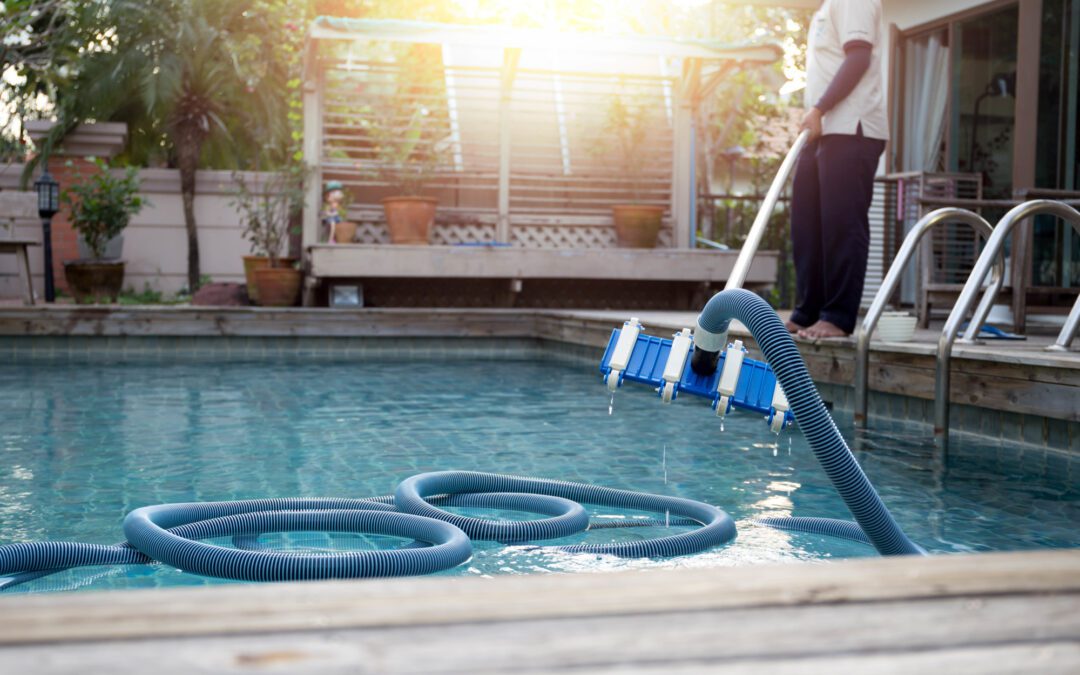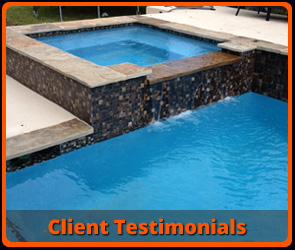Are you curious about how to keep your beautiful, custom pool looking great?
Keeping up with weekly pool maintenance is an essential task as a responsible pool owner. Correctly taking care of your pool will make it look beautiful for longer.
Continue reading to see how our weekly pool maintenance checklist can help you keep your pool sparkling clean.
Weekly Pool Maintenance Checklist
Texas pool maintenance does not have to be overwhelming! This weekly pool maintenance checklist can help you keep track of your regularly scheduled pool care.
- Skim
- Brush
- Vacuum
- Check and adjust water levels
- Check and adjust chemical levels
- Add algaecide or shock treatment (if necessary)
- Clean deck or the surrounding area
Weekly Pool Maintenance Tips
Are you still looking for more information? Don’t worry! Here are some tips or things to consider when following the weekly pool maintenance checklist.
Skimming Your Pool
When taking care of your pool, the first thing you should do is remove any foreign objects floating around in the water.
It is common for leaves, sticks, and other debris to find their way into your pool water, but you can easily remove these objects by using a pool skimmer.
Pool skimmers use a long handle to skim any unwanted debris easily from the surface of the water.
Brushing Your Pool
No, your pool will not grow hair, but you still need to brush it!
Once you have cleared the pool from larger, floating pieces of debris, the next step is to brush the smaller debris from the walls and floor of the pool.
When you brush the walls of your pool, it may be helpful to use a pool brush with a telescopic pole to reach the bottom of the walls.
Different types of pool cleaners are also available to use in tandem with your brush to remove difficult stains or grime.
Depending on what material the bottom of your pool is made from, there are different types of brushes you can use. You can brush tougher pool bottoms like tile pools with more abrasive brushes than if you have a vinyl pool liner.
To properly brush your pool, brush down the walls with consistent motion. Brush the debris from the walls and floors towards the main drain in the pool that is typically located in the deep end.
Also, do not forget to brush any steps, jets, and corners your pool may have.
Vacuuming Your Pool
A quick way to remove debris from the bottom of your pool is to vacuum it out. Although there are many types of pool vacuums, here are two main categories: automatic and manual.
Automatic pool vacuums are less time-consuming and physically demanding than manual vacuums, but they are more expensive. Manual vacuums are labor-intensive, but they can save you money.
Vacuuming a pool works in the same way that vacuuming carpet in a house does. For automatic pool vacuums, set them up according to manufacturer standards and watch them go.
For a manual pool vacuum, also set them up according to manufacturer standards. Then move it along the floor of the pool to suck up any dirt or unwanted debris.
Checking and Adjusting Water Levels
Once you have removed all unwanted debris from your pool, the next step in pool care is to check your water levels.
A good rule of thumb for pool water level is that it should reach the halfway mark of the skimmer built into the wall of your pool.
Maintaining a proper water level allows the pool to circulate and function properly. It is also important for keeping the chemical levels in your pool balanced.
Checking and Adjusting Chemical Levels
Your pool’s chemical levels are an important aspect of keeping it clear and clean.
Saltwater pools’ chemical levels will need to be monitored. The salt level in a saltwater pool should be between 2,700 and 3,400 ppm (parts per million). Maintaining proper salinity in your pool is essential for reducing the growth of algae and bacteria.
If you have a chlorine pool, checking the pH level of the water is something that you will need to do regularly. Your chlorine pool should have a pH level between 7.2 and 7.8.
If the water’s pH is too high, it can cause skin irritation and cloudy water. If the water’s pH is too low, it becomes corrosive to your pool equipment and can cause damage.
Adding Algaecide and Pool Shock
If during your weekly pool maintenance routine you notice an algal bloom, you will need to clean it immediately. You can clean it manually with an algae brush, or you can treat it chemically with an algaecide.
Shocking your pool does not include using electricity! It is the process of adding chemicals (chlorine or non-chlorine) to your pool water to increase the amount of free chlorine by breaking up combined chlorines.
Combined chlorines are not able to sanitize your pool properly, so it is important to increase the level of free chlorine.
The two aspects of pool care should not need to be done weekly, but it is important to look out for issues that may warrant the addition of algaecide or pool shock during your weekly pool maintenance.
Cleaning the Pool Deck or Surrounding Area
The final step in your weekly pool maintenance routine should be to clean the area that surrounds your pool.
Sweeping the leaves, dirt, and sticks from your pool deck can help prevent the mess from falling into your pool later in the week. Being proactive in your cleaning can help save you time and energy later!
Caring For Your Pool
Being consistent with weekly pool maintenance will allow you to escape the Texas heat and enjoy a pristine pool for longer.
We hope these weekly pool maintenance tips will help you in your future pool care. For more information on how to finance or build your custom pool, contact us for a free consultation today!




